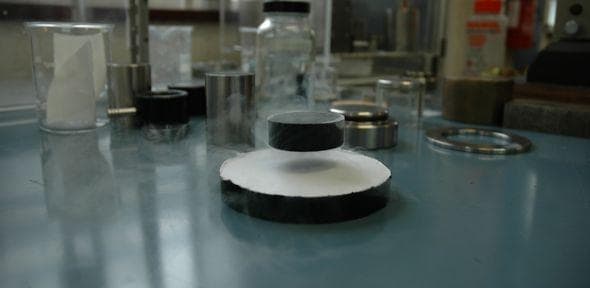University of Cambridge Engineers Break The Record For Trapped Magnetic Field In A Superconductor
A team of engineers at University of Cambridge have managed to break the world record for the trapped magnetic field in a superconductor. The previous record was created over a decade ago and stood at 17.24 Tesla and was achieved by a team led by Professor Masato Murakami from the Shibaura Institute of Technology in Japan. The Cambridge team managed to create a magnetic field with strength of 17.6 Tesla. To put things into perspective, we would like to inform you that a fridge magnet has strength of 0.001 Tesla. This makes the superconductor from the University of Cambridge over a hundred times more powerful. So how did they manage to achieve this feat, we shall get to it in the next paragraph.
The team used a high temperature gadolinium barium copper oxide (GdBCO) superconductor. As most of you know superconductors are materials that are able to transmit electrical current with little or no resistance when cooled below a certain temperature. While conventional ones need absolute zero (-273 degrees centigrade) temperatures, high temperature ones do so at -196 degrees. This higher temperature meant that they could be easily cooled with the help of liquid nitrogen. The team took 25 mm diameter samples of GdBCO high temperature superconductor and formed it in to a single grain using melt processing to increase its current carrying and thermal performance. They later reinforced it with a stainless steel ring to trap the magnetic field. They opted for stainless steel because conventional cuprates would have exploded under the extreme magnetic field.

A bulk superconductor levitated by a permanent magnet
The team hopes to develop commercial application for this superconductor within the next five years. With this experiment they have successfully demonstrated the potential of high temperature superconductor for applications in various fields such as flywheels for energy storage, magnetic separators in mineral refinement, pollution environment and levitating monorail.
To read more about this development, you can head over to the <a href="https://www.cam.ac.uk/research/news/cambridge-team-breaks-superconductor-world-record" target="_blank" rel="nofollow noopener noreferrer">Cambridge team breaks superconductor world record | University of Cambridge</a> and its coverage on #-Link-Snipped-#.
The team used a high temperature gadolinium barium copper oxide (GdBCO) superconductor. As most of you know superconductors are materials that are able to transmit electrical current with little or no resistance when cooled below a certain temperature. While conventional ones need absolute zero (-273 degrees centigrade) temperatures, high temperature ones do so at -196 degrees. This higher temperature meant that they could be easily cooled with the help of liquid nitrogen. The team took 25 mm diameter samples of GdBCO high temperature superconductor and formed it in to a single grain using melt processing to increase its current carrying and thermal performance. They later reinforced it with a stainless steel ring to trap the magnetic field. They opted for stainless steel because conventional cuprates would have exploded under the extreme magnetic field.

A bulk superconductor levitated by a permanent magnet
The team hopes to develop commercial application for this superconductor within the next five years. With this experiment they have successfully demonstrated the potential of high temperature superconductor for applications in various fields such as flywheels for energy storage, magnetic separators in mineral refinement, pollution environment and levitating monorail.
To read more about this development, you can head over to the <a href="https://www.cam.ac.uk/research/news/cambridge-team-breaks-superconductor-world-record" target="_blank" rel="nofollow noopener noreferrer">Cambridge team breaks superconductor world record | University of Cambridge</a> and its coverage on #-Link-Snipped-#.
0
